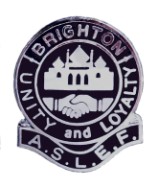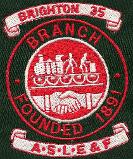
IGNITING THE SUSSEX BEACONS
OF UNITY
THE HISTORY OF THE
SUSSEX BRANCHES OF A.S.L.E.F.
EVERY PICTURE TELLS A STORY
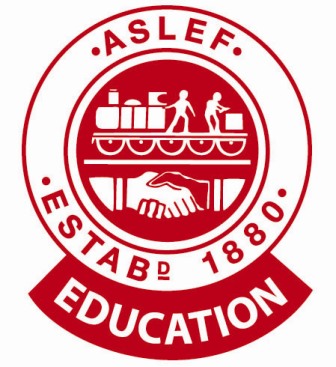 | One of the main reasons for doing these web sites is to try and explain to everybody the history of the footplate grades, the conditions they had to work in and the creation of the A.S.L.E.F. branches within the Brighton & Sussex area. I am therefore very grateful for people sending me personal photos from their personal collection and for allowing me to display them on the web sites. But unfortunately what is missing, are the stories that accompany them. What I want to do is to try and remedy this by starting to record the remaining stories that are still out there, before they too are lost in the midst of time. I have added some information about some of the drivers that I know and the comments that have already have been sent to me. If you too have any stories about your own working life on the footplate, the people that you worked with and the conditions you had to work in please send me and I will post, on the web site. If you are interested in helping me in capturing these stories by any means possible please let me know. |
Researched by Dave Shopland, Ray Young Roy Luxford
THREE BRIDGES LOCOMOTIVE SHEDS
The First Shed
A wooden shed of some sort is believed to have been brought into use when the line to Horsham was completed on 14th February 1848 and possibly expanded when the allocation was increase to cover the East Grinstead branch duties from 9th July 1855, engines were stationed from Horsham’s allocation. The station was called “Crawley” until the Horsham branch opened.
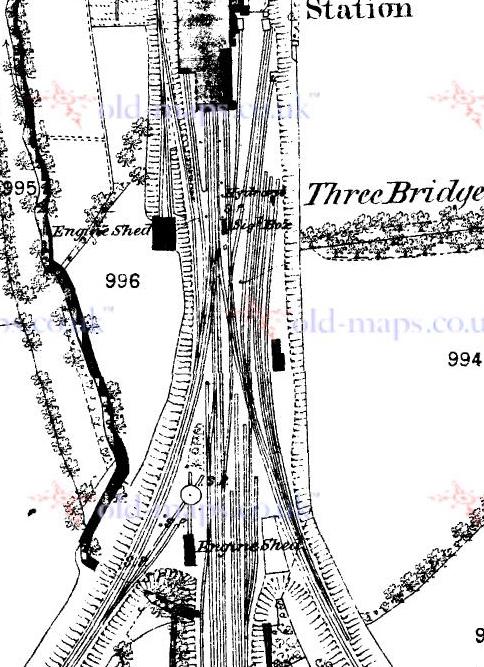
Ordnance Survey map 1874
The Second Shed
This was a two road shed affair with a slated pitched roof, the brick building from 1860 when the Horsham line was doubled. It is unclear whether this was built on the site as the original shed, but the location was one of singularity and character tucked away at a lower level on the west side of the original station, sharing space with a cramped goods yard. A glimpse down to this quaint little corner can be seen on the far left of the station-scape, the major buildings were a sawmill and an 1860s goods shed probably constructed at the same time as the brick engine shed, later this goods shed was closed as new yards were laid to the south, east and west of the Brighton main line, and it appears to have been taken over by the sawmill as photographs show it surrounded by baulks of timber. In the photograph there appears to be more sidings than shown in the ordinance survey maps, one of which on the west side with a small building near the neck is the coaling stage.
The shed accommodated up to six; small locomotives, but by the turn of the century many overnighted outside or even in the small goods yard opposite especially if out of working order, amidst the most sylvan surroundings. The final addition to this cramped complex was the construction of a pump house in 1905 to replace the stationary engines. The word ‘Tank’ appears in Ordnance Survey map it was certainly not located in the roof of the engine shed. The 1897 O/S map (right) shows the three previously identified buildings adjacent to the yard sidings on the west side with the gas-works next to the river Mole.
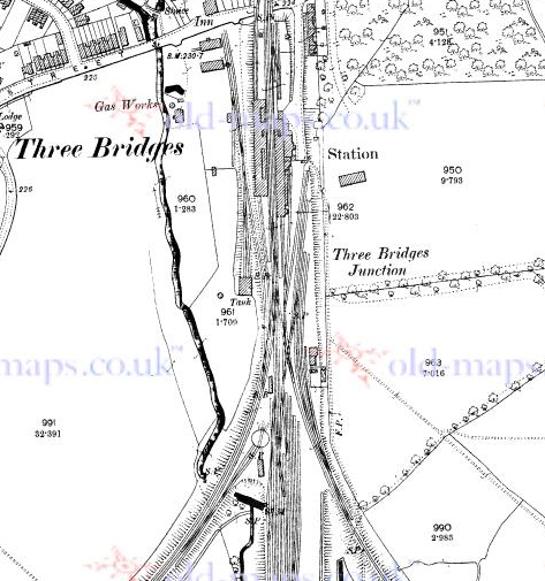
By the turn of the century the locomotive depot had virtually taken over the former small goods yard, which had to accommodate sets of locomotives needing to reverse into the shed. Not all the facilities into this restricted hemmed in by the close proximity of the river Mole and the 45ft turntable and water tank had been located in the fork of the Brighton Horsham lines.
The 1897 O/survey map which shows the station and tank sheds, but not the third shed. In 1911 the station shed had gone!
Loco No. 38 ' Millwall' photo taken outside Three Bridges Loco Shed in 1904
The Third (Transitional/Tank) Shed
This was the so called ‘Tank’ shed nicknamed by virtue of the water tank which stood on top a long single road shed. The exit to the north was straight onto a 45ft turntable, which lay right at the apex of the Horsham branch’s divergence from the main line, with two roads accessing to a reversing siding beside the Horsham lines. While the second shed was in operation, the Horsham lines must have been frequently occupied by locomotives crossing-over between the two servicing points.
When the widening of the lines and the extension of the station commenced and claimed the space and site of the second shed, the ‘Tank’ shed stood in until completion of the new shed sited a few hundred yards further south on the east side of the main line and close to the Horsham line. It became the ‘Engine Shed’ as indicated in the 1911 O/S map (right), and was converted from dead-end to through pattern permitting access via the west marshalling yard. A spur ran beside the coaling platform, and locomotives stood overnight in two sidings close to the shed and in the new short sidings close to the shed and in the new short sidings emanating from the turntable. The new depot was probably brought into use about 1904.
The 1897 survey which showed the station and tank sheds, but not the third shed. In 1911 the station shed had gone.
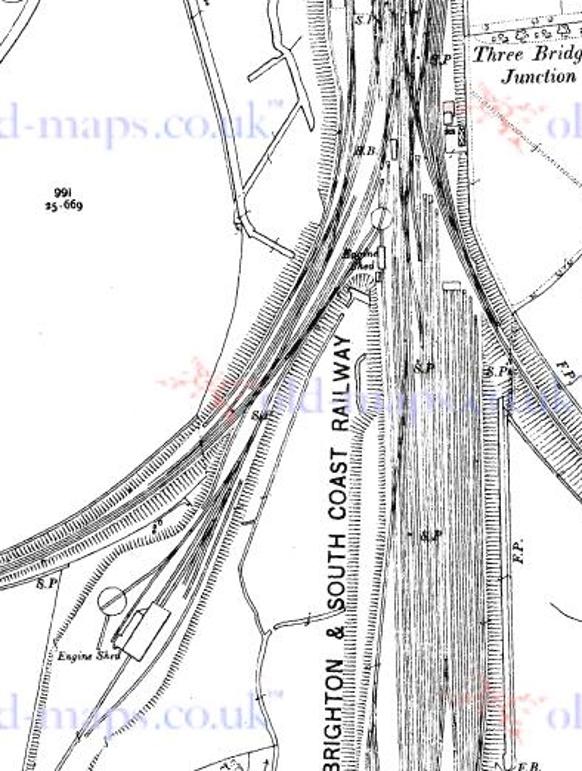
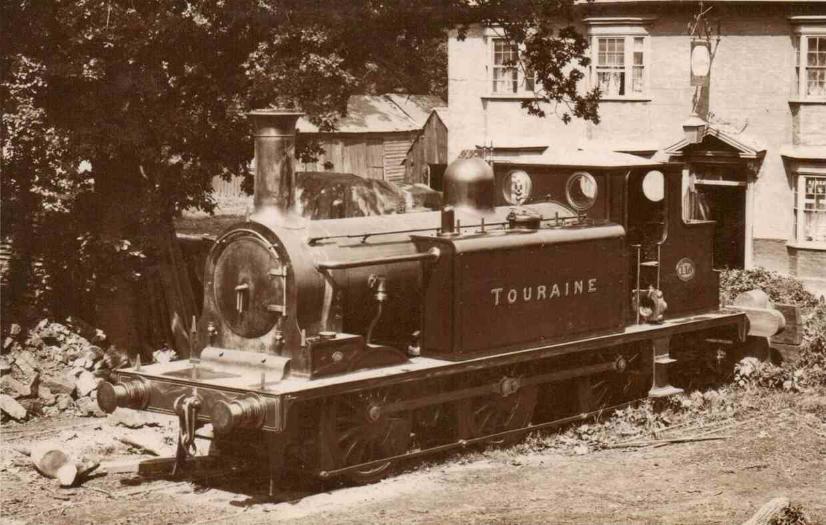
The Forth Shed
The next and final shed was constructed in 1909, in open space upon an extension to the embankment carrying the Horsham lines using infill from the widening of the mainline. The new three road structure was built in brick with north-light pattern roof and tall adjacent water tank. A 60ft turntable was fitted in alongside the shed in the space between the Horsham lines, and the complex included large and small hoists, a corrugated iron machine shop with a curved roof, mess rooms and store offices, a pumping engine boiler house with its tall chimney, its fire also used for sand drying. Coal stages were provided on the north and south sides of the yard respectively, the latter improved with the addition of a canopy and crane. Over to the east was a spread of sidings known as ‘The Park’, accommodating empty coal wagons and the occasional stored locomotive. Accommodation was for around two dozen locomotives, overtaking its parent depot of Horsham and gaining separate independence status.
Up to World War 2, the allocation remained pure ‘Brighton’. It closed to steam in June 1964, Brighton taking over its remaining duties, but diesels locomotives continued to be stabled in the yard. The surviving buildings were used as a rolling stock, especially wagons, repair shops were demolished in the mid-1970s.
The workings from this shed have been described by Dick Kirby in |Vol. 15 no. 5. The shed was unique by virtue of its central position on the system, which led to its engines working regularly over most parts of the L.B.S.C.R.
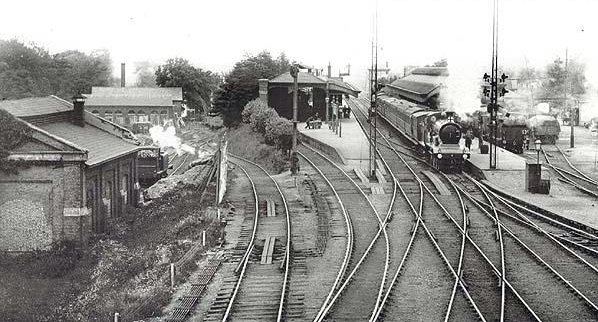
Three Bridges station pre 1909
On the left hand side is the orignal Loco Shed which closed in 1909
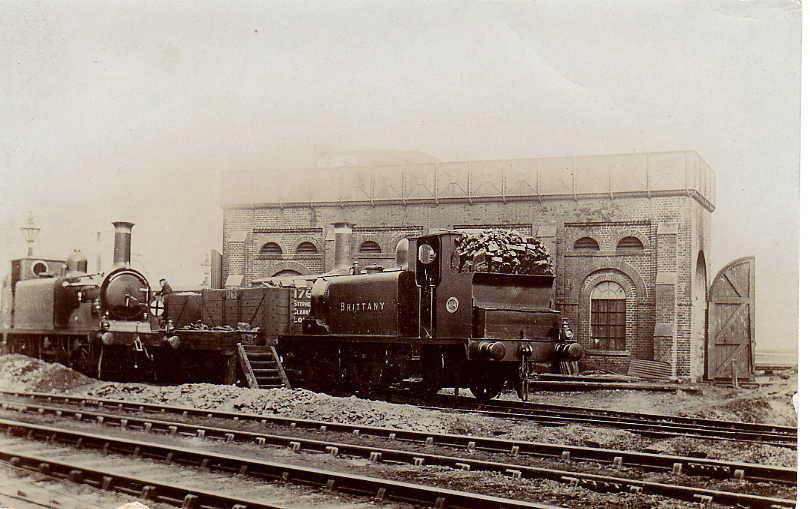
THE WORKING OF THE SMALLER L.B.S.C.R. LOCO SHEDS.
Among the smaller sheds, Three Bridges was unique in that its central position on the system, which meant that over its life its engines worked regularly to most parts of the London Brighton & South Coast Railway. The only lines over which there does not to appear to recorded that Three Bridges engines working are Polegate to Hastings, Chichester to Midhurst, West Croydon to Epsom Downs, Wimbledon & Hayling branch line
The actual date when the first shed at Thee Bridges was opened on the upside adjacent to the station is obscure. It was certainly was not built when the line was opened in 1841. The Horsham branch (1848) was worked from Horsham shed, and the East Grinstead branch (1855) from East Grinstead shed, until it absorbed into the L.B.S.C.R. in 1865. Following the opening of the Horsham to Petworth line in 1859 an amendment to the working timetable dated December 1859 shows a 5.45 a.m. goods Three Bridges to Petworth and 9.0 a.m. return “worked from Three Bridges” so it would seem there was a shed there then.
Opening of the Hardham Junction to Ford section in August 1863, increased the importance of Three Bridges as there was now a service of local trains between Three Bridges and Ford, plus expresses to and from Portsmouth formed of carriages to/or detached from main line express trains at Three Bridges. Three Bridges shed shared the local trains to Ford but the Portsmouth express were worked exclusively by Portsmouth engines some of which spent several hours at Three Bridges. The Petworth goods ceased at the same time being replaced by a goods from Littlehampton to Three Bridges and back.
In 1870 Three Bridges had three turns. One made two local passenger trips to Ford and back, the second four trips to East Grinstead and back, starting and finishing with goods trips, while the third was a 3.15 p.m. slow to Portsmouth, and back along the coast to Brighton, finishing with the 9.0 p.m. to Haywards Heath and light engine to Three Bridges.
By 1886 the new station at East Grinstead and the line from South Croydon to Culver Junction had been opened. Three Bridges shed had some Stroudley Class “D” and “E” tank engines, plus some 2-4-0 and 0-6-0 types from the Craven era, and five turns including one to London. The London trip was on the 8.45 a.m. East Grinstead to London Victoria via Oxted, and after some suburban working the engine worked the 4.0 p.m. London Victoria to Tunbridge Wells as far as Three Bridges where the engines were changed over. It then took the carriages off the 5.5 p.m. London Bridge to Eastbourne to East Grinstead, returning with a goods train back to Three Bridges.
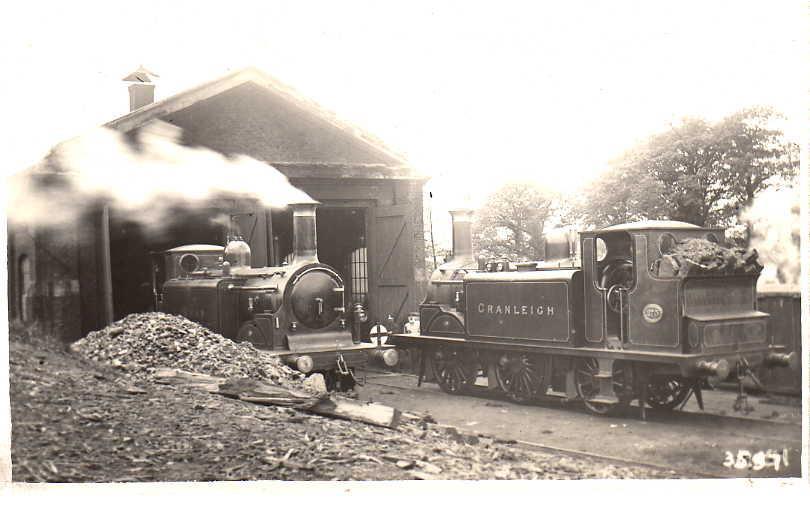
The other turns were:
Locals to Littlehampton and back to Three Bridges.
1, Goods to Redhill Goods, then (Mon, Wed & Fri) to Crawley, Norwood and back to Three Bridges. (Tues, Thurs, & Sat) to East Grinstead, Crawley, Redhill Junction (SER) and back to Three Bridges
2, Goods train to Tunbridge Wells and back to Three Bridges
3, Goods train to Tunbridge Wells and shunting duties at Three Bridges.
By 1896 the Redhill goods shunting engine formerly based at Earlswood was based at Three Bridges and the “D” tank shedded at East Grinstead since 1883 was also at Three Bridges. The shed now had five passenger turns, and two goods turns for which a stud of Class “D1s” and “E1s” were allocated passenger jobs which included three turns to London, the original 8.40 a.m. ex East Grinstead, the 8.08 a.m. Lewes via Sheffield Park which was formerly worked by the East Grinstead engine, and a new working from Horsham to London via the “Back Road” (Dorking and Streatham.
The other two turns were local trains to Tunbridge Wells and to Brighton and Worthing.
The two goods turn were:
1, Goods train to Redhill Junction then to Haywards Heath, where 3 ½ hours of shunting time permitted, plus trips between Haywards Heath to Horsted Keynes, Lewes or Hassocks as required before returning back to Three Bridges.
2, Carriages off the 5.05 p.m. London Bridge to Eastbourne to East Grinstead, return back to Three Bridges with a goods train. After arriving at Three Bridges it then work the “Night Good Pilot,” shunting at Three Bridges.
By 1911 the Three Bridges shed allocation of engines had increase to nine (“D1” Nos. 249, 258, 275, 03, 390, 394. “E1” 101, 110. “E4” 465 & “E5” 587), and the workings of eight, with trips to Bognor and Tunbridge Wells. The local goods trips to Redhill and Haywards Heath had ceased and instead Three Bridges had a “Roundabout” turn to hove via Horsham, and returning back to Three Bridges via Hassocks, workings which up to that time had been the sole prerogative of the Brighton Shed.
Above L.B.S.C.R Three Bridges Locomotive workings for October 1912
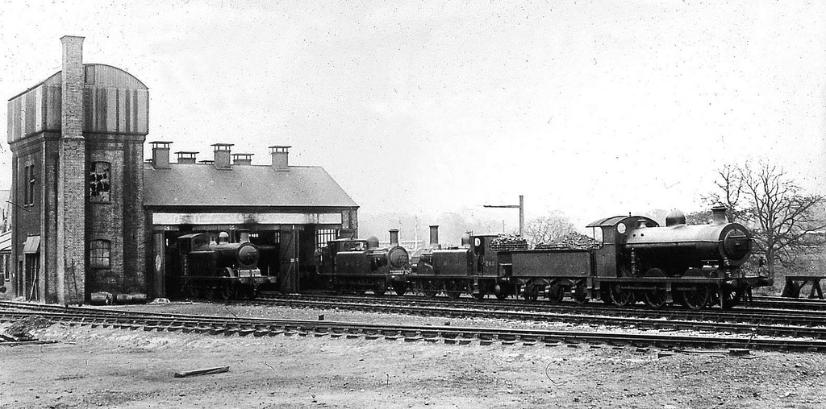
During the 1914-1918 War and the 1919 agreement which limiting the engine-men’s hours to an eight hour day, changed the pattern of freight working on the L.B.S.C.R., and had a profound effect on the work of Three Bridges shed. The former brought London North West Railway (L.N.W.R.) and Great Western Railway (G.W.R.) locomotives to Three Bridges until 1921, when the L.B.S.C.R took over the workings which continued until after the Second World War. The early morning trip from Three Bridges to Old Oak Common and back was always worked by an E4. The Willesden trip which started from Three Bridges in the late evening was worked a Three Bridges engine Class C2/x until the Class K was allocated, when they were used. It was always worked by Three Bridges men, although for a short time in the 1930 the diagram was part of Brighton cyclic working. The reduction in engine-men’s hours resulted in goods work being based on starting from yards and working out instead of depots like Midhurst and Tunbridge Wells working in.
During the Southern Railway era there were so many changes in the workings it would take far too long to list them all. The allocation of engines at Three Bridges grew to a maximum of 33 engines in 1933, for 16 turns. The London turns grew to a maximum of four in 1932, but they varied over the years. The 8.35 a.m. from Forest Row remained a Three Bridges turn throughout, as did the 8.57 a.m. Tunbridge Wells to London via Three Bridges, until it was withdrawn in 1932. The 8.08 a.m. Lewes to London Bridge via East Grinstead was Three Bridges work, except for 1925 to 1927, when it became a Redhill working, until 1933 when the Brighton shed took over the work. Other service taking Three Bridges engines to London were 10.50 a.m. and 6.25 p.m. Tunbridge Wells West to London Bridge, 1.40 p.m. Horsham to London Bridge, 4.20 p.m. Horsham to London Victoria (both via the Back Road), and 3.35 p.m. Haywards Heath to London Bridge via East Grinstead.
In the summer of 1930 for the first time a regular Sunday passenger turn was put on working to Brighton and back to Three Bridges in the morning, then in the evening leaving Three Bridges at 6.52 p.m. for London Bridge returning via Oxted and East Grinstead. This ceased in 1932 and there was no Sunday work until 1938, when a news and milk working was put on from Three Bridges to Billingshurst and back. This absence of Sunday work seems to have remained up until its final closure.
Over the years Horsham and Three Bridges sheds were generally managed as one entity. In the L.B.S.C.R. days the Horsham allocation was generous to provide spares for both sheds. For most of the time Horsham remained the principal shed, but in later the mantle passed to Three Bridges. Both sheds had one thing in common, during the lifetime of the L.B.S.C.R.; they had little or no Sunday work. The only Sunday work at Three Bridges of a regular nature was the provision of a “Stand-by engine” on Sundays in summer, a practice which the Southern Railway carried on until electrification in 1933. For a time a Class B1 was allocated and covered this duty, it also worked week day excursions, particularly at the beginning and the end of the summer season, Cooks, Restall and the National Sunday League ran excursions from London down to the coast which divided at Three Bridges for e.g. Brighton/ Bognor, Brighton/Eastbourne, and the B1 would also take over the detached portion.
There were fewer return services and prior to suburban electrification some of the Three Bridges engines worked trains to Coulsdon North, and the running light engine back to the Bridges. Up to 1933 the engine of the 8.08 a.m. ex-Lewes returned on Mondays to Fridays as far as Redhill midday goods from Bricklayers to Reading. On Saturdays it worked the 12.40 p.m. London Bridge to Gomshall and back to Redhill thence each day light engine to Redhill Goods for a fright trip to Three Bridges. Other return workings were 12.50 (N9) Battersea Yard to Three Bridges, 12.40 p.m. (SO) Victoria to Horsham, and the 12.22 a.m. (NM) Bricklayers Arms to Reading (as far as Redhill) thence the 2.40 a.m. goods to Three Bridges.
Up to 1933 the London turns were work by Classes E4 or E5 Radials, but the Brighton electrification released some Class I3s, which worked some of the turs until they were banned from the Three Bridges to Ashurst Junction section, and some I1/xs were drafted in. The I3s returned in 1942.
Other passenger turns during the Southern Railway era took Three Bridges engines on to the Uckfield line, Steyning line, and Dyke Branch (from 1924), to Cranliegh and Guildford (from 1926), to Seaford and Tonbridge in 1929, to Redhill via Tonbridge in 1930 and in 1931 there was working over the ‘Cuckoo line’.
Although rail motor trains were frequent visitor to Three Bridges, none were based there except for a six month period January to July 1933 when duty 660, rostered for a Class D1/m ran light to Haywards Heath for the 6.40 a.m. to Oxted and after visiting Tunbridge Wells, Brighton, Seaford, and Uckfield, finishing with the 7.36 p.m. Horsted Keynes to Haywards Heath and then light engine back to Three Bridges. The next motor workings based on Three Bridges, seem to have been in 1955 when some Class M7’s were allocated for working between Three Bridges, East Grinstead, Tunbridge Wells West and Oxted.
Goods working over this period, apart from the cross London workings already mentioned, included two Steyning “Roundabouts”, one in each direction, local trips to East Grinstead, Horsham, Guildford, Tunbridge Wells and Redhill. After the Eastbourne line electrification in 1935, Three Bridges had some goods and van workings to both Eastbourne and Newhaven.
The Three Bridges Yard pilot was a Class “E1” lasted well into the British Railways era and was supplanted first by a Class “E4” and later by a 350 h.p. diesel shunter locomotive. The Redhill Goods shunter was transferred to Redhill shed in 1927.
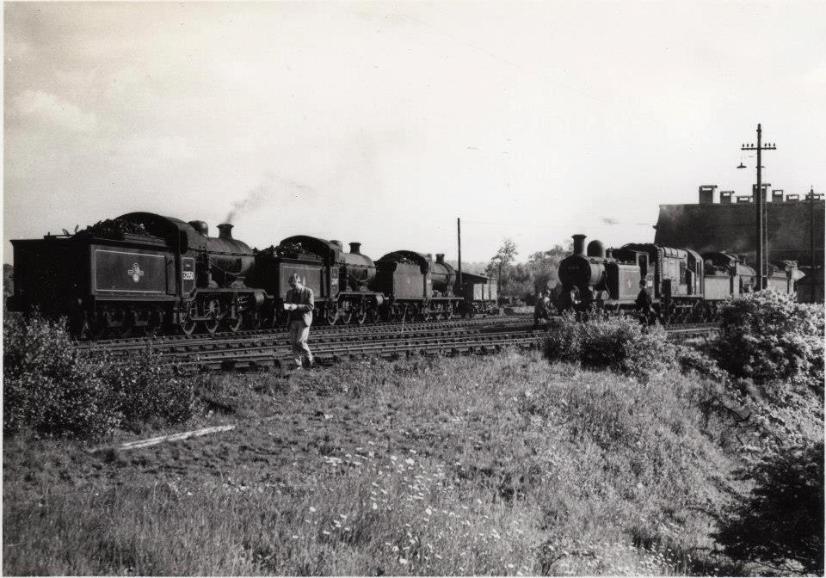
As in the first world war so the larger shed built in the fork of the Brighton and Horsham lines in 1909 with its 50ft turntable, repair facilities and central location on the system proved invaluable not in war time freight traffic but for turning servicing of variety of engines at the time of the Dunkirk evacuation. Once again foreign engines in the shape of London Midland Scottish, 8Fs and others appeared on through trains from the L.M.S. system and War Department 2-8-0’s appeared on the Southern.
After the war the allocation of predominantly ex-L.B.S.C.R. classes gradually gave way to “foreign” types L.M.S. 4P and 2P classes, M7 0-4-4T’s and Q and Q1 Class 0-6-0’s.
In 1945, there were three running links of twelve, one shunting link of six, one shed link of five, made up of “Green Card men” and “Passed Men”, ten Engine Cleaners, three Running Foreman, four Fitters and their mates, five Boiler makers and their mates, ten women shed staff and a Coal-man. This was a total of 94 members of staff employed at Three Bridges loco shed.
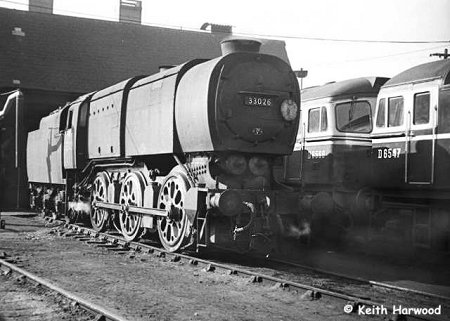
Three Bridges Loco Shed c1964
At the grouping of the railways in 1948, Three Bridges shed had 16 locomotives for 10 turns. Half the allocations were Class “E4s” and Class “E5 Radials”, and there were therefore many mixed traffic diagrams. Six were basically passenger turns including three to London, and the others, there was now work to Eastbourne. The four freight turns were to Old Oak Common, Willesden, a Steyning line “Roundabout”, and a turn to Tunbridge Wells and back including a trip from East Grinstead to Kingscote. The two shunting turns were at Three Bridges and Redhill Goods Yards.
The workings remained largely the same until the eventual decline in wagon load freight, and the closure of branch lines, plus the introduction of dieselisation which brought the closure of the shed, but was still used as signing on point in 1964, and the steam depot become a Mixed Traction depot. Three Bridges Mixed Traction depot closed on the same day as Eastbourne M.T. and Feltham depots in April 1969.
Among the smaller sheds Three Bridges was unique in that it’s central position on the system meant that its life it’s engines worked regularly to most parts of the L.B.S.C.R. The only lines which there is no record of Three Bridges engines working are Polegate to Hasting, Chichester to Midhurst and West Croydon to Epsom and Wimbledon.
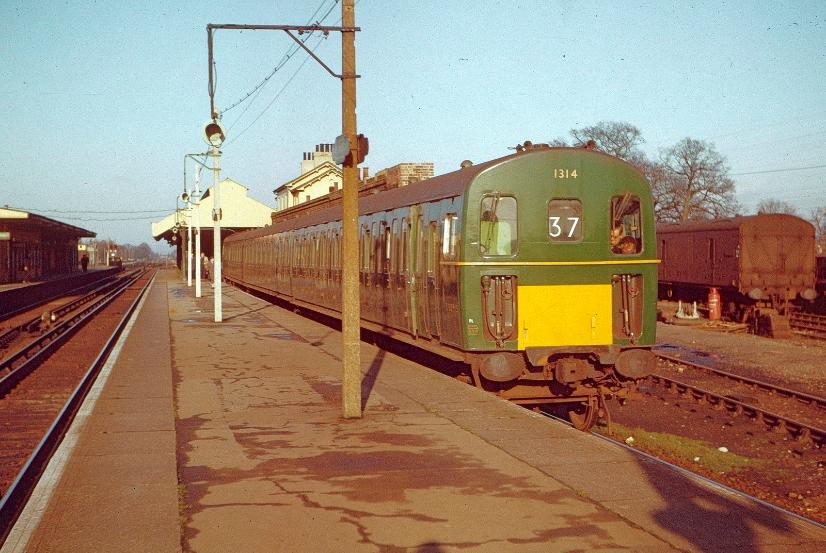
THREE BRIDGES TO TUNBRIDGE WELLS WEST
Thee Bridges Motorman/E.M.U.T. Depot
A motorman’s depot opened with arrival of electrification in 1932. The site of the depot was on platform 3 in the former waiting room building. Some time in the 1950s they moved into the buildings on platform 5. They later moved to its current location on platform 2 in the old buffet in 1969 when the loco shed close.
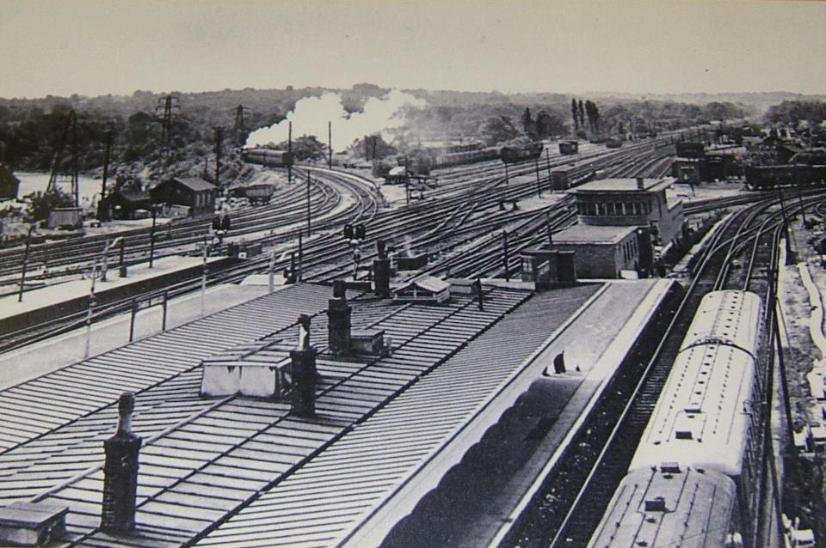
PAUL BARBER COLLECTION
PAUL BARBER COLLECTION
Virgin Trains Depot
For a short period of time 2001/2 – 2008, Virgin trains had a small maintenance depot on the site of the 4th loco shed for their Cross country Voyagers. These were worked by drivers from the Brighton virgin depot.
THAMESLINK DEPOT
A new Thameslink depot opened in 2016 on the site of the old goods yard. It will house and to maintain the new fleet of Siemen’s units which are to be used to be on the Thameslink cross London services, between towns in Sussex to towns and cities such as:- Peterborough, Cambridge & Bedford, and will come into operation in 2018. In addition to the main depot building will be able to take up to five 12-car trains at a time for repairs and for upgrades, and holding sidings for storing Thameslink trains. Also on this site, will include a warehouse, office space, train cleaning equipment.
Nearby to the this complex, on the site of the 4th loco shed, is the new Three Bridges signal box, which is going to be one of fourteen state-of-the-art rail operating centres (signal boxes), which will replace more than 800 signal boxes across the country.
